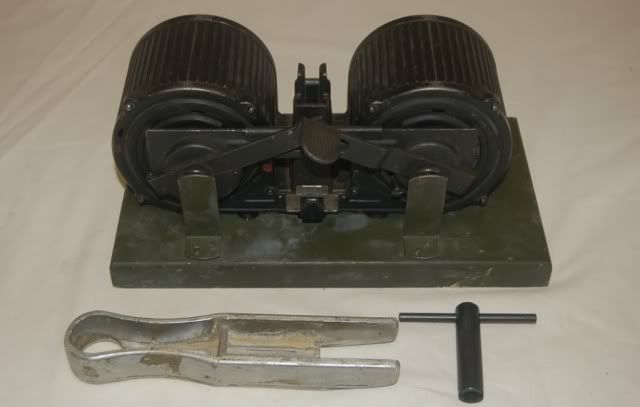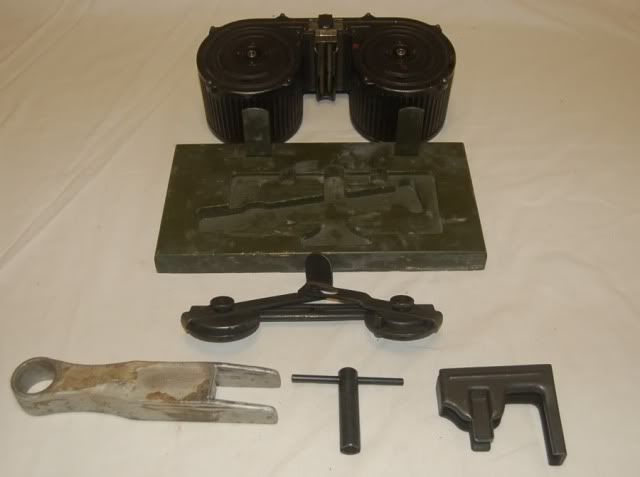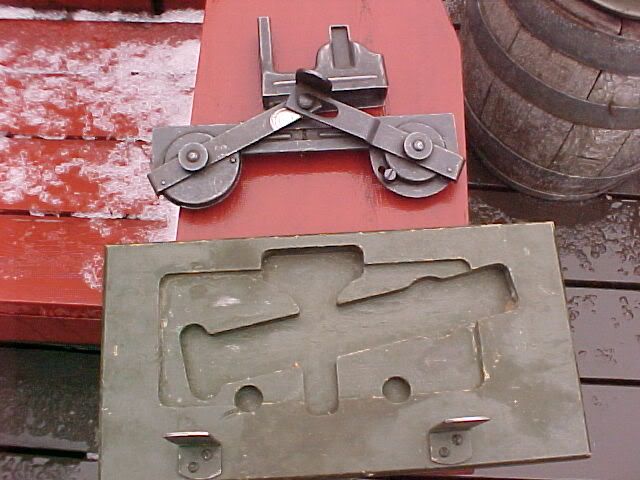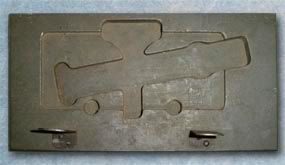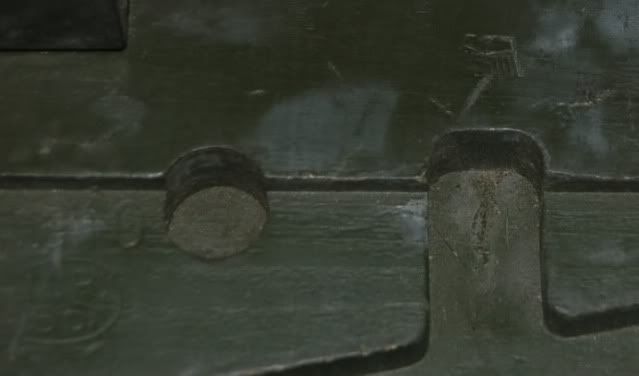Bil wrote:Does the ground adapted gun use a differant barrel than when it was aircraft mounted? (the 15) I know it has the mount provision in the grip,but was anything changed in front of the saddle drums? And how close is the Japanese version? Very nice! Wish there was a semi conversion. ---bil
Bil, there are really two answers for your "ground conversion" question. The Germans only ever issued the MG-15 as a ground service gun using the original air-cooled barrel, essentially merely taking the bare minimum steps to adapt the stock air-service guns for use in the ground role. This was basically accomplished by the development of four unique (to the MG-15) attachments- One, a long cast-aluminum cradle-shaped sleeve that allowed the front end of the air-cooled barrel jacket to be clamped and held tightly inside the closed bottom half. This was equipped with two mounting points where a std MG-34 bi-pod could be locked into place, front or back just like the MG-34 mounting positions. Two, a clamp-on detachable shoulder stock that was almost taken straight from the MG-13 but suitably modified to slide over the rear of the MG-15 grip-housing. Third, a dedicated cartridge ejection port dust-door that also did double duty when opened as a cartridge case deflector.....absolutely necessary due to POSITIVE ejection the gun exhibited and without, could cause serious injury to the shooter or anybody near the bottom or sides of the gun. Lastly, there were a couple of special sight sets (front + rear) issued for use when in the ground service mode; they seem to have initially just issued the gun with the common late-style air-combat sights (like on my gun in the video) and then with experience developed a special set of dual-service sights that were micrometer-wheel adjustable for ground ranging, and used in combination with a companion front spider sight that included a fixed post for ground use. These later dual-service sights were pretty darn complex and thus likely quite expensive to make and it seems that likely were not made in great quantity.....they are rare today, surviving examples. Period pictures show the MG-15 in Luftwaffe ground service with all combination of sights, and in fact, with all sorts of mounting adaptations......some guns were used with all these extras, and I have seen plenty that were just basically wired to a post sunk in the ground or similar. It seems that while there existed a definitive program to supply a complete range of accessories to adapt the MG-15 "officially", the farther the guns got from Berlin.....the more the field-expedient type adaptations prevailed.
These same sorts of ground-service adaptations also existed officially for almost all the Luftwaffe air-service guns that had originally been available for flexible mountings in aircraft....MG-15, MG-81(single), MG-131...there are even examples found that mounted the superb MG-151 cannon in both calibers (15/20mm) to ground mountings (Lafette & wheeled carriages). Though much rarer, at least a certain few examples were known to have been discovered of MG-17's mounted in Zwilling (twin) & Vierling (quad) mounts as airfield defences. Point being, the Germans were exceptionally resourceful and were highly reluctant to let go of a proven weapons system just because the air-war had marched on beyond a particular weapons usefulness as an air-combat weapon. Various and sundry special ground-service accessories were designed for all these adaptations.....besides the MG-15, the ground mount fittings and sights for the MG-81 are probably the most common. One has to marvel that these guns, in particular the MG-15 & MG-81, were quite well seen in common airfield defense service as with the extremely high rates for fire and lack of cooling potential, firing any of these guns on the ground would almost certainly destroy the barrels and perhaps the entire guns in VERY short order......a couple-three drums or belts. Clearly these weapons, while quite effective probably due their high volumes of fire potential when cool, would only have been fired in desperation presumably as neither really has a "quick-change barrel" capability as we normally think of it, nor could you easily or quickly reload the MG-15 drums or MG-81 belts in the field, as neither gun was ever intended to be field-serviced. And also, there never existed anything other than the specialized reloading equipment for either, so again presumably, when your MG-15 drum stash ran dry.....you dropped the gun and were done as reloading the drums in the field was really just not feasible.
That pretty much covers the -German Military- adaptations for the MG-15 in ground service; Now we come to the much considered water-cooled conversion of the MG-15 which was known as the ST-61. There has been much written, and >argued< as to the story of these guns, and it appears that the definitive answers are lost to history and we are left with only surviving physical examples and some anecdotal evidence to go from so I won't conjecture here on that anymore that I already have in other threads on this site elsewhere. Suffice it to say, the ST-61 water-cooled variant exists so we can at least examine the physical evidence. Basically this variant seems be a wholly-commercial venture undertaken by Rheinmettal-Borsig and actually built at the French arsenal at St. Etienne sometime after 1943. All such guns are marked on the receiver with only R-B commercial markings and logos, bear no waA or acceptance stamps, and also seem to have never been recorded in any official German military records, the long-standing rumour is that they were commissioned late in the War by the Romanian Government and procurement/delivery probably never actually happened. The base conversion from an air-cooled aircraft gun to a water-cooled dedicated ground gun was accomplished by developing a very simple water-jacket assembly, which also carried a dedicated bi-pod and a set of ground sights, and the whole thing screwed onto the front of the regular receiver in place of the air-cooled barrel jacket with no modifications needed to the receiver. The water-cooled jacket required a dedicated water-cooled type barrel that fit the jacket openings and had provisions for water-proofing the opening via the common use of packing materials. Beyond that , the only other difference was the inclusion of a clamp-on fixed tube-type of butt-stock, that again, was copied nearly directly from the MG-13 stock. The ST-61 stock clamp was slightly different than the second type of MG-15 stock clamp. Most of these ST-61 guns seemed to have survived the War in an unissued state and were only relatively recently sold on the MIL-SURP market about 10 years ago. A parts-set of the water-cooled parts will fit right onto a air-cooled MG-15 receiver with no modifications.
Your last question regards the similarity of the Japanese copies of the MG-15. In general, the Japanese cloned exactly the German guns, up to and including accepting the original German chambering of 7.92 x 57mm ammunition. There are two distinct variants of the Japanese clones, differentiating (as almost all wartime Jap guns do) between those made and used by the Imperial Army and the Imperial Navy. The IJA made and used what they called the Type 98 variant which in almost areas is an exact copy, differing only by the Japanese markings usually. The Japanese Navy produced themselves at their Yokusuka Arsenal and also procured additional guns (from the IJA Nagoya Arsenal under contract to the IJN) what they called the Type 1 gun, which is USUALLY found equipped with a second vertical pistol grip located just behind the ejection port of the gun. IJN Type 1's are the only MG-15 type guns to have this second grip and not all Type 1's have it. The gun I have is a IJN Type 1 and clearly exhibits this unique feature as you can see above. Beyond that there are only small differences in markings, finish, and cosmetic finish between them. Guns of both Types may be found with either wooden or bakelite rear grip housings, depending upon where and when they were made; late-War guns typically used the bamboo wood housings and were not blued or finely finished.
All parts and accessories will directly interchange between German and Japanese production; shooting a Jap-made gun with more common German internal parts is well advised as there is no chance of replacing any of the original Japanese parts,while German MG-15 parts are -relatively- common still. There is one stupid difference between German and Japanese DT-15 drums- the metric cap screws used to hold the cover plate of the drums are different thread specs.
According to noted Japanese scholar Edwin Libby, the Yokosuka Arsenal produced IJN Type 1 guns like mine are quite rare, even during the War, as they likely made somewhat less than 2000 of them total and certainly all but a very few did not survive the War intact or preserved. The fact that my Yokusuka Arsenal-made Type 1 did, completely intact and in pristine condition, is simply a mystery as to how and why. And contrary to urban legends, these Japanese machine guns are exceptionally well crafted and manufactured, equally on par with anything Germany produced.
-TomH








